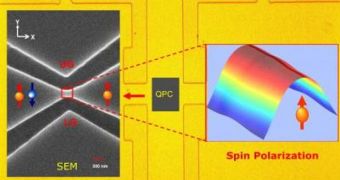Scientists at the University of Cincinnati have recently discovered an innovative, new method of controlling the spin orientation of electrons – an area of research known as spintronics – using nothing more than electrical means. This has long since been hypothesized as possible, but has never been scientifically proven before, team members say. Details of the find were published in the latest issue of the highly respected scientific journal Nature Nanotechnology, in a paper called “All-Electric Quantum Point Contact Spin-Polarizer.”
Transistors, the small electrical elements inside television sets, computers, and radios, transmit information by controlling the movement of the charge of an electron. This is the way things have been done for the past few decades, and now scientists are planning to use spintronics to innovate this field. The new approach does not rely on controlling the charge of the electron, but on its spin. It is estimated that a spintronic transistor would consume much less energy, generate a lot less heat, and operate at higher speeds than the existing ones, created on a charge-control basis.
“Until now, scientists have attempted to develop spin transistors by incorporating local ferromagnets into device architectures. This results in significant design complexities, especially in view of the rising demand for smaller and smaller transistors,” UC McMicken College of Arts & Sciences Department of Physics Research Professor Philippe Debray says. Marc Cahay, a professor in the Department of Electrical and Computer Engineering, has also been a co-leader of the investigation.
“A far better and practical way to manipulate the orientation of an electron's spin would be by using purely electrical means, like the switching on and off of an electrical voltage. This will be spintronics without ferromagnetism or all-electric spintronics, the holy grail of semiconductor spintronics,” Debray explains. “We used a quantum point contact – a short quantum wire – made from the semiconductor indium arsenide to generate strongly spin-polarized current by tuning the potential confinement of the wire by bias voltages of the gates that create it,” he adds.
“The key condition for the success of the experiment is that the potential confinement of the wire must be asymmetric – the transverse opposite edges of the quantum point contact must be asymmetrical. This was achieved by tuning the gate voltages. This asymmetry allows the electrons – thanks to relativistic effects – to interact with their surroundings via spin-orbit coupling and be polarized. The coupling triggers the spin polarization and the Coulomb electron–electron interaction enhances it,” he concludes. Partial funding for the groundbreaking work came from the US National Science Foundation (NSF).

 14 DAY TRIAL //
14 DAY TRIAL //